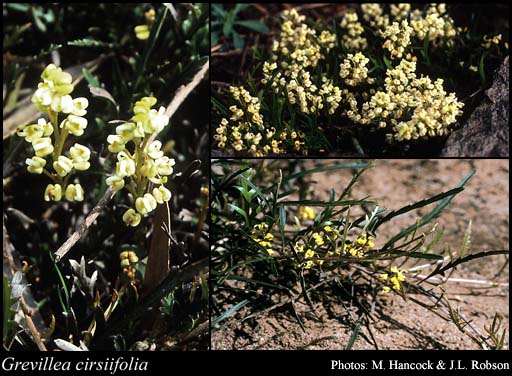- Reference
- Lehm., Pl.Preiss. [J.G.C.Lehmann] 2:253 (1848)
- Conservation Code
- Not threatened
- Naturalised Status
- Native to Western Australia
- Name Status
- Current
Prostrate shrub, 0.1-0.45 m high, 0.5-2 m wide. Fl. white-cream-yellow, Jul or Sep to Dec. Sandy loam, clay loam, gravel.

Scientific Description
Shrubs, 0.10-0.30 m high; branchlets hairy, not glaucous. Leaves alternate, 45-200 mm long, 5-30 mm wide, hairy, on the abaxial surface, the hairs straight; lamina flat, once divided or twice or more divided, pinnately divided, divided to the midrib; lobes 4-10 mm long, 3-10 mm wide, the margins flat. Inflorescences axillary or terminal, white or cream; pedicels 6-11 mm long. Perianth 4-6 mm long; tepals fused (at least at base) after flower opens, hairy, simple-hairy; ovary hairy, stipitate, the stipe 0.5-1 mm long; pistil 5-7 mm long, yellow, pollen presenter lateral, style glabrous. Follicles hairy, not viscid, dehiscent, 10-11.5 mm long. Flowers in October, November or December. Occurs in the South-west (SW) Botanical Province(s), in the Avon Wheatbelt (AW), Jarrah Forest (JF), Mallee (MAL) or Warren (WAR) IBRA subregion(s).
Distribution
- IBRA Regions
- Avon Wheatbelt, Jarrah Forest, Mallee, Warren.
- IBRA Subregions
- Katanning, Northern Jarrah Forest, Southern Jarrah Forest, Warren, Western Mallee.
- Local Government Areas (LGAs)
- Beverley, Boddington, Bridgetown-Greenbushes, Broomehill-Tambellup, Cranbrook, Denmark, Kojonup, Kulin, Manjimup, Nannup, Narrogin, Wandering, West Arthur, York.